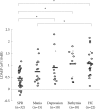Serotonergic dysfunction in patients with bipolar disorder assessed by the loudness dependence of the auditory evoked potential
- PMID: 22993531
- PMCID: PMC3440481
- DOI: 10.4306/pi.2012.9.3.298
Serotonergic dysfunction in patients with bipolar disorder assessed by the loudness dependence of the auditory evoked potential
Abstract
Objective: The loudness dependence of the auditory evoked potential (LDAEP) is suggested to be a marker of serotonin system function. This study explored the LDAEP of multiple mood statuses (depression, mania, and euthymia) and its clinical implication in bipolar disorder patients.
Methods: A total of 89 subjects, comprising 35 patients with bipolar disorder, 32 patients with schizophrenia, and 22 healthy controls were evaluated. The bipolar disorder cases comprised 10 depressed patients, 15 patients with mania, and 10 euthymic patients. The N1/P2 peak-to-peak amplitudes were measured at 5 stimulus intensities, and the LDAEP was calculated as the slope of the linear regression. Both cortical and source LDAEP values were calculated.
Results: LDAEP varied according to mood statuses, and was significantly stronger in cases of euthymia, depression, and mania. Cortical LDAEP was significantly stronger in patients with bipolar euthymia compared with schizophrenia, stronger in bipolar depression than in schizophrenia, stronger in healthy controls than in schizophrenia patients, and stronger in healthy controls than in patients with bipolar mania. Source LDAEP was significantly stronger in patients with bipolar euthymia, bipolar depression, and bipolar mania compared with schizophrenia, stronger in bipolar euthymia than in bipolar mania. Psychotic features weakened the source LDAEP relative to nonpsychotic features. The severity of the depressive symptom was negatively correlated with source LDAEP.
Conclusion: These findings suggest that the serotonin activity of patients with bipolar disorder may vary according to mood status. A longitudinal follow-up study should be pursued using drug-naive subjects.
Keywords: Bipolar disorder; LDAEP; Mood status; Serotonin.
Figures




Similar articles
-
Clinical Usefulness of Loudness Dependence of Auditory Evoked Potentials (LDAEP) in Patients with Bipolar Disorder.Psychiatry Investig. 2013 Sep;10(3):233-7. doi: 10.4306/pi.2013.10.3.233. Epub 2013 Sep 16. Psychiatry Investig. 2013. PMID: 24302945 Free PMC article. Review.
-
The loudness dependence of the auditory evoked potential (LDAEP) in schizophrenia, bipolar disorder, major depressive disorder, anxiety disorder, and healthy controls.Prog Neuropsychopharmacol Biol Psychiatry. 2010 Mar 17;34(2):313-6. doi: 10.1016/j.pnpbp.2009.12.004. Epub 2009 Dec 11. Prog Neuropsychopharmacol Biol Psychiatry. 2010. PMID: 20005279
-
Clinical implications of loudness dependence of auditory evoked potentials in patients with atypical depression.Prog Neuropsychopharmacol Biol Psychiatry. 2014 Oct 3;54:7-12. doi: 10.1016/j.pnpbp.2014.05.010. Epub 2014 May 24. Prog Neuropsychopharmacol Biol Psychiatry. 2014. PMID: 24865151
-
The Loudness Dependence of Auditory Evoked Potentials (LDAEP) in individuals at risk for developing bipolar disorders and schizophrenia.Clin Neurophysiol. 2016 Feb;127(2):1342-1350. doi: 10.1016/j.clinph.2015.10.050. Epub 2015 Nov 11. Clin Neurophysiol. 2016. PMID: 26639170
-
Affective disorders and the loudness dependence of the auditory evoked potential: Serotonin and beyond.Neurosci Lett. 2024 Mar 28;827:137734. doi: 10.1016/j.neulet.2024.137734. Epub 2024 Mar 17. Neurosci Lett. 2024. PMID: 38499279 Review.
Cited by
-
Epistatic Interactions between CREB and CREM Variants in Affective Disorder.Psychiatry Investig. 2014 Apr;11(2):200-3. doi: 10.4306/pi.2014.11.2.200. Epub 2014 Apr 11. Psychiatry Investig. 2014. PMID: 24843377 Free PMC article.
-
Association between the loudness dependence of auditory evoked potentials and age in patients with schizophrenia and depression.J Int Med Res. 2022 Jul;50(7):3000605221109789. doi: 10.1177/03000605221109789. J Int Med Res. 2022. PMID: 35808808 Free PMC article.
-
Can the Loudness Dependence of Auditory Evoked Potentials and Suicidality Be Used to Differentiate between Depressive Patients with and without Bipolarity.Psychiatry Investig. 2013 Jun;10(2):143-7. doi: 10.4306/pi.2013.10.2.143. Epub 2013 May 30. Psychiatry Investig. 2013. PMID: 23798962 Free PMC article.
-
Examining the underpinnings of loudness dependence of auditory evoked potentials with positron emission tomography.Neuroimage. 2020 Jun;213:116733. doi: 10.1016/j.neuroimage.2020.116733. Epub 2020 Mar 10. Neuroimage. 2020. PMID: 32169543 Free PMC article.
-
Clinical Usefulness of Loudness Dependence of Auditory Evoked Potentials (LDAEP) in Patients with Bipolar Disorder.Psychiatry Investig. 2013 Sep;10(3):233-7. doi: 10.4306/pi.2013.10.3.233. Epub 2013 Sep 16. Psychiatry Investig. 2013. PMID: 24302945 Free PMC article. Review.
References
-
- Hegerl U, Juckel G. Intensity dependence of auditory evoked potentials as an indicator of central serotonergic neurotransmission: a new hypothesis. Biol Psychiatry. 1993;33:173–187. - PubMed
-
- Park YM, Kim DW, Kim S, Im CH, Lee SH. The loudness dependence of the auditory evoked potential (LDAEP) as a predictor of the response to escitalopram in patients with generalized anxiety disorder. Psychopharmacology (Berl) 2011;213:625–632. - PubMed
-
- Lee SH, Park GH. Psychophysiological Markers of Anxiety Disorders and Anxiety Symptoms. In: Kalinin V, editor. Anxiety Disorders. Rijeka: InTech; 2011. pp. 203–226.
-
- Lee SH, Kim JH, Lee JH, Kim S, Park YM, Bae SM, et al. Aberrant response of selective serotonin reuptake inhibitor in two patients with high N100 amplitude slope. Korean J Psychopharmacol. 2008;19:341–347.
LinkOut - more resources
Full Text Sources

